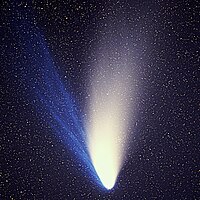Comet Hale-Bopp
 | |
| Discovery | |
|---|---|
| Discovered by: | Alan Hale and Thomas Bopp |
| Discovery date: | July 23, 1995 |
| Alternate designations: | The Great Comet of 1997, C/1995 O1 |
| Orbital characteristics A | |
| Epoch: | 2450460.5 |
| Aphelion distance: | 370.8 AU[1] |
| Perihelion distance: | 0.914 AU[1] |
| Semi-major axis: | 186 AU |
| Eccentricity: | 0.995086 |
| Orbital period: | 2520[2]-2533[1] yr |
| Inclination: | 89.4° |
| Last perihelion: | April 1, 1997[1] |
| Next perihelion: | ~4385[3] |
- For Hale Bopp, a 1997 composition, see Celtic Voices and Hale Bopp
Hale-Bopp was discovered on July 23, 1995, at a great distance from the Sun, raising expectations that the comet would brighten considerably by the time it passed close to Earth. Although predicting the brightness of comets with any degree of accuracy is very difficult, Hale-Bopp met or exceeded most predictions when it passed perihelion on April 1, 1997. The comet was dubbed the Great Comet of 1997.
The passage of Hale-Bopp was notable also for inciting a comet-related panic. Rumours that an alien spacecraft was following the comet gained remarkable currency, and inspired a mass suicide among followers of the Heaven's Gate cult.
Contents[show] |
[edit] Discovery
The comet was discovered in 1995 by two independent observers, Alan Hale and Thomas Bopp, both in the United States.[4]Hale had spent many hundreds of hours searching for comets without success, and was tracking known comets from his driveway in New Mexico when he chanced upon Hale-Bopp just after midnight. The comet had an apparent magnitude of 10.5 and lay near the globular cluster M70 in the constellation of Sagittarius.[5] Hale first established that there was no other deep-sky object near M70, and then consulted a directory of known comets, finding that none were known to be in this area of the sky. Once he had established that the object was moving relative to the background stars, he emailed the Central Bureau for Astronomical Telegrams, the clearing house for astronomical discoveries.[6]
Bopp did not own a telescope. He was out with friends near Stanfield, Arizona observing star clusters and galaxies when he chanced across the comet while at the eyepiece of his friend's telescope. He realized he might have spotted something new when, like Hale, he checked his star maps to determine if any other deep-sky objects were known to be near M70, and found that there were none. He alerted the Central Bureau for Astronomical Telegrams through a Western Union telegram. Brian Marsden, who has run the bureau since 1968, laughed, "Nobody sends telegrams anymore. I mean, by the time that telegram got here, Alan Hale had already e-mailed us three times with updated coordinates."[7]
The following morning, it was confirmed that this was a new comet, and it was named Comet Hale-Bopp, with the designation C/1995 O1. The discovery was announced in International Astronomical Union circular 6187.[5][8]
The comet may have been observed by ancient Egyptians during the reign of pharaoh Pepi I (2332–2283). In Pepi's pyramid in Saqqara is a text referring to an "nhh-star" as a companion of the pharaoh in the heavens, where "nhh" is the hieroglyph for long hair. [9]
[edit] Early observation
Hale-Bopp's orbital position was calculated as 7.2 astronomical units (AU) from the Sun, placing it between Jupiter and Saturn and by far the greatest distance from Earth at which a comet had been discovered.[10][11] Most comets at this distance are extremely faint, and show no discernible activity, but Hale-Bopp already had an observable coma.[5] An image taken at the Anglo-Australian Telescope in 1993 was found to show the then-unnoticed comet some 13 AU from the sun,[12] a distance at which most comets are essentially unobservable. (Halley's Comet was more than 100 times fainter at the same distance from the Sun.)[13] Analysis indicated later that its nucleus was 60±20 kilometres in diameter, approximately six times the size of Halley.[1][14]Its great distance and surprising activity indicated that Comet Hale-Bopp might become very bright indeed when it reached perihelion in 1997. However, comet scientists were wary – comets can be extremely unpredictable, and many have large outbursts at great distance only to diminish in brightness later. Comet Kohoutek in 1973 had been touted as a 'comet of the century' and turned out to be unspectacular.[6]
